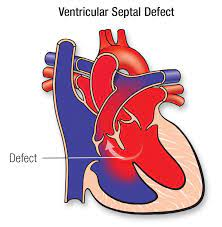The nurse is caring for a 4-month-old with a history of ventricular septal defect. The infant is admitted for failure to thrive. What supportive measure would the nurse anticipate in an infant with congestive heart failure?
increased caloric density of Formula
Oxygen therapy to ensure oxygen saturation is > 98%
Sedatives to keep the infant from crying
Emergent surgical correction of the defect
The Correct Answer is A
Infants with congenital heart defects, including VSD, may have increased caloric needs due to the added work of their hearts. Congestive heart failure can lead to poor weight gain and failure to thrive. Therefore, increasing the caloric density of the formula is a common approach to providing the necessary nutrition for growth and development. This can be achieved by using specialized high-calorie infant formulas or fortifying breast milk.
The other options are not the primary supportive measures for an infant with congestive heart failure in this context:
B. Oxygen therapy to ensure oxygen saturation is > 98%: While oxygen therapy may be necessary for infants with congenital heart defects, it is not the primary supportive measure to address failure to thrive. Oxygen therapy primarily aims to ensure adequate oxygenation but does not directly address caloric intake.
C. Sedatives to keep the infant from crying: The use of sedatives is not a typical approach to managing congestive heart failure in infants. Addressing the underlying cause, optimizing nutrition, and providing supportive care are more appropriate strategies.
D. Emergent surgical correction of the defect: Surgical correction of a VSD is typically considered for specific indications, such as significant hemodynamic compromise, but it is not the first-line intervention for all cases of VSD, especially if the primary concern is failure to thrive. Treatment decisions for VSD are made based on the specific clinical presentation and severity of the defect.

Nursing Test Bank
Naxlex Comprehensive Predictor Exams
Related Questions
Correct Answer is ["480"]
Explanation
To calculate the total volume the patient will receive, you can use the formula:
Total Volume = Rate x Time
In this case, the rate is 20 mL/hr, and the time is 24 hours. Now, calculate:
Total Volume = 20 mL/hr x 24 hr = 480 mL
So, the patient will receive a total of 480 mL of the 0.9% NS solution.
Correct Answer is A
Explanation
A. Weighing the child daily (A) is the most accurate and objective method for monitoring fluid retention in a child with nephrotic syndrome. Nephrotic syndrome can lead to significant fluid retention due to proteinuria and hypoalbuminemia. Daily weight measurements can detect even small changes in body weight, which may be indicative of fluid accumulation. It is a sensitive and specific measure for assessing fluid status.
B. Measuring the abdominal girth weekly (B) can provide some information about abdominal distension, but it is not as precise or sensitive as daily weight measurements. Weight gain or loss can occur without significant changes in abdominal girth, especially in children.
C. Counting the number of wet diapers (C) may provide some information about urinary output, but it does not directly measure overall fluid retention or body weight changes. It is not as reliable as daily weight measurements for assessing fluid status.
D. Testing the urine for hematuria (D) is a valuable diagnostic test to assess kidney function and the presence of blood in the urine, but it does not directly measure fluid retention. Hematuria is not typically the primary indicator of fluid overload in nephrotic syndrome.
In summary, daily weight measurements are the best way to monitor fluid retention in a child with nephrotic syndrome, as they provide a direct and objective assessment of changes in fluid status. This allows healthcare providers to make timely adjustments to the child's treatment plan if necessary.
Whether you are a student looking to ace your exams or a practicing nurse seeking to enhance your expertise , our nursing education contents will empower you with the confidence and competence to make a difference in the lives of patients and become a respected leader in the healthcare field.
Visit Naxlex, invest in your future and unlock endless possibilities with our unparalleled nursing education contents today
Report Wrong Answer on the Current Question
Do you disagree with the answer? If yes, what is your expected answer? Explain.
Kindly be descriptive with the issue you are facing.
